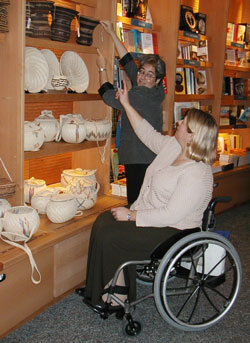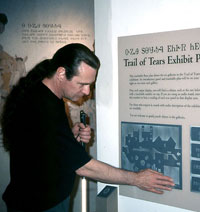| U.S. Department of Justice Civil Rights Division Disability Rights Section |
|
Expanding |
Maintaining Accessibility in Museums |
| Your Market |
|
|
Introduction According to the Institute for Museum and Library Services, there are about 17,500 museums across the United States that care for more than 750 million objects and live specimens in order to engage the public in learning about everything from artists' masterworks to the composition of an atom to the history of barbed wire. (1,2) These museums - a term used broadly to include zoos, historic sites, botanical gardens, aquariums, planetariums, children's museums, and science and technology centers -- range in size from a small historic house to a large art museum with a related range in annual budgets from a few thousand to several hundred million dollars. (2) Regardless of size or income, most museums have legal obligations to provide and maintain accessibility for visitors with disabilities: Privately operated museums are covered as public accommodations under title III of the Americans with Disabilities Act (ADA); museums operated by state or local governments are covered by the ADA's title II; and museums that receive Federal funding - whether they are covered by title II or title III -- are also covered by Section 504 of the Rehabilitation Act. Museum Investments in Access Since the 1970s, numerous museums across the country have initiated efforts to improve the accessibility of their buildings and programs for visitors with disabilities. Today, museums that invest time and money to remove barriers from their facilities, design accessible exhibitions, and provide effective communication for their programs can potentially attract to their doors more than 50 million Americans with disabilities, more than 20 million families with members who have disabilities, and millions of graying Baby Boomers. (3,4) Elements such as entrances without stairs, exhibit labels that can be read by visitors who are seated or standing, large-print exhibition brochures, and captioned multimedia programs help museums reach this huge and growing audience. The key to protecting these investments is maintaining the accessibility that has been put into place -- both the general features of a public accommodation and features and programs that particularly define a museum experience. When accessibility programs and services are discontinued or accessible building features are blocked by temporary exhibitions or removed during renovations, the loss of invested time and money can be substantial. |
Characteristics of an Accreditable Museum "The museum strives to be inclusive and offers opportunities to diverse participation." American Association of Museums
Code of Ethics for Museums "Thus the museum ensures that: . . . programs are accessible and encourage participation of the widest possible audience
consistent with its mission and American Association of Museums
|
Maintaining Accessible Features in Museum Buildings
Museum buildings are often city landmarks and as much a part of the museum experience as the exhibitions and programs within them. The following are examples of typical museum building accessibility maintenance issues: Accessible Entrances
|
||
Accessible Routes Throughout the Museum

|
||
Maintaining Accessibility in Museum Programs
|
 |
Accessibility enables all visitors to participate in an enriched museum experience. Investing in access - and maintaining that investment - brings museums the valued rewards of inclusive programming and a new, diverse audience. |
Maintaining Accessibility in Museum Shops
- Museum shops must not allow merchandise to spill into aisles and narrow the width of the accessible route.
- Sales and ticket counters that have been lowered to provide access must be clear and unobstructed for use by people with disabilities.
- Staff should know how to assist people who need help in reaching or seeing merchandise.
For specific information about how to comply with the ADA and reach this nearly untapped audience of people with disabilities, visit the U.S. Department of Justice's ADA Business Connection site at www.ada.gov; or, call the toll-free ADA Information Line:
800-514-0301 (voice); 833-610-1264 (TTY)
APRIL 2009
Duplication is encouraged.
The Americans with Disabilities Act authorizes the Department of Justice (the Department) to provide technical assistance to individuals and entities that have rights or responsibilities under the Act. This document provides informal guidance to assist you in understanding the ADA and the Department's regulations.
This guidance document is not intended to be a final agency action, has no legally binding effect, and may be rescinded or modified in the Department's complete discretion, in accordance with applicable laws. The Department's guidance documents, including this guidance, do not establish legally enforceable responsibilities beyond what is required by the terms of the applicable statutes, regulations, or binding judicial precedent.
Return to Business Connection Home Page
last updated April 29, 2009
References
1. American Association of Museums. "Museums FAQ." n.d. <www.aam-us.org/aboutmuseums/ abc.cfm#how_many> (10 October 2008).
2. Able, Edward, H., Jr. "Statement Before the Subcommitee on Federal Financial Management, Government Information and International Affairs, Committee on Homeland Security and Government Affairs" United States Senate. 05 April 2006. <www.hsgac.senate.gov/public/_files/040506Able.pdf> (14 October 2008).
3. U.S. Census Bureau. "Americans with Disabilities: 2002 Household Economic Studies." May 2006. <www.census.gov/prod/2006 pubs/p70-107.pdf> (15 May 2006).
4. U.S. Census Bureau. "Disability and American Families: 2000." July 2005. <www.census.gov/prod/2005pubs/censr_23.pdf> (7 April 2006).





 Once inside the building, visitors with disabilities want to fully experience all that museums have to offer –
exhibitions, programs, special events, publications, and videos. The following are examples of typical museum
program maintenance issues:
Once inside the building, visitors with disabilities want to fully experience all that museums have to offer –
exhibitions, programs, special events, publications, and videos. The following are examples of typical museum
program maintenance issues: